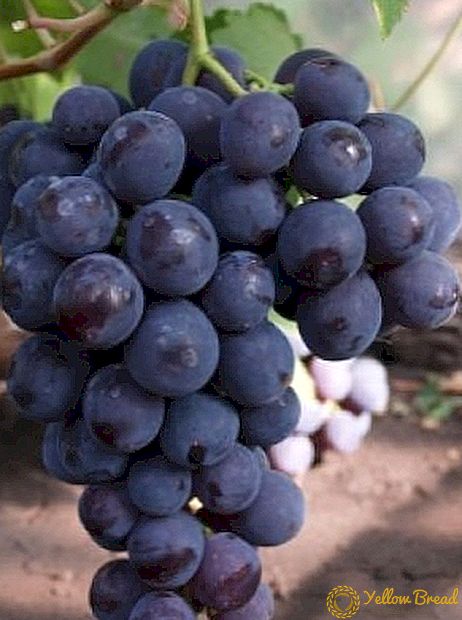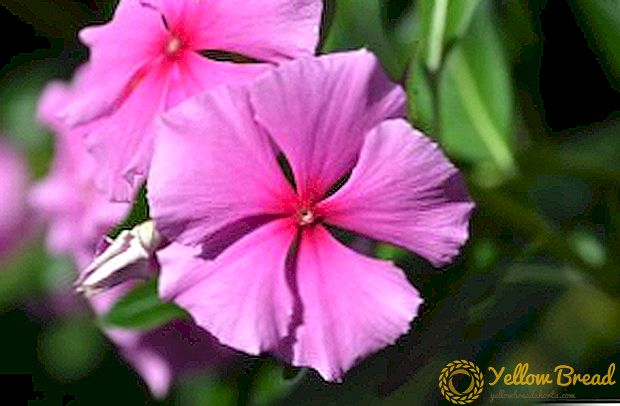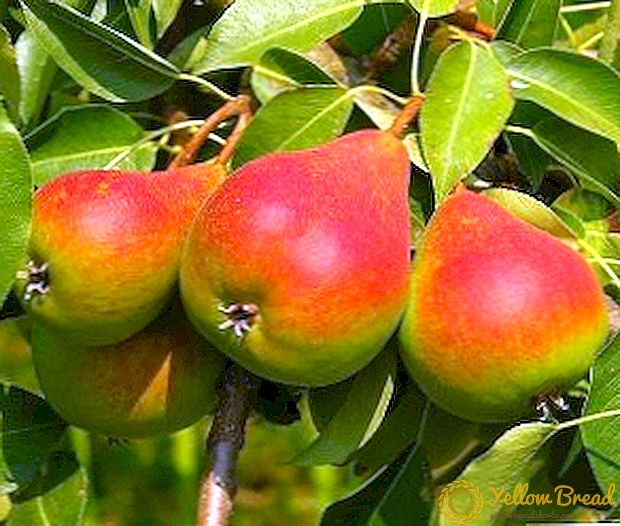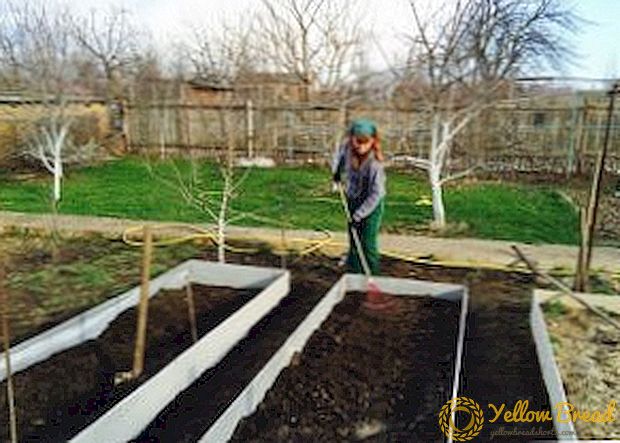
Every year, through the efforts of breeders, more and more new varieties of grapes appear.
Despite the fact that this culture is known to mankind for thousands of years, it remains as promising as before.
After all, the enthusiasm of real lovers of grapes can not be appeased, and they spend all their free time to create the most perfect grape variety.
One of such amateur breeders is EG Pavlovsky.
And today we will introduce you to one of its newest grape varieties, which has already managed to win the love of many.
It will be about grapes "Rochefort" and the rules of planting and caring for this beautiful variety.
Rochefort's varietal features: distinctive grape varieties

This variety appeared in private vineyards of Ye.G. Pavlovsky, who used the Talisman grape variety as a parental form of "Rochefort", crossing it with a variety pollinated with a mixture of European-Amur grape forms called "Cardinal". The result was a fairly stable variety of grapes, which practically does not require attention from the grower.
Due to this, as well as the wide zoning of the variety and its good fruiting, "Rochefort" is increasingly found in private areas of grape lovers like EG Pavlovsky himself.
Distinctive features and main characteristics of bunches of grapes "Rochefort"
An important role in the evaluation of each grape variety is the size of its clusters and the taste of berries.
In the case of the Rochefort grape, there is no need to worry about it, since all its characteristics are high.
In particular, its clusters are very large in size and weigh on average about 0.5-0.9 kilograms. Their appearance is rather elegant, the berries are tightly placed, they have a conical shape.
According to professional experts, the quality of the presentation of these clusters is almost 100%, which makes them the benchmark for other varieties. A distinctive feature of the grapes of grapes described varieties in the first place is their color. It can vary from dark red to dark purple, and even black, when overripe harvest.
The shape of the berries is also interesting: they are round, but slightly flattened on the sides. The average size of the berries are 2.8x2.6, with a mass of 7-9 grams. With good farming, individual berries can reach a weight of 12 grams.
The taste of the Rochefort grapes is quite harmonious, saturated with the delicate and pleasant aroma of muscat. The fleshy and tender flesh gives a special refinement to the taste. The skin also does not affect the taste, although in this class it is rather dense.
About the sweetness of grapes can be judged by the percentage of sugar accumulation, which is 14-15%. At the same time, the acidity of the berries is at a relatively low level - 4-5 g / l.
Features of fruiting and ripening time of the crop

Despite all the beauty of grapes and excellent taste of berries, the yield of these grapes is average, and in rare years with good care is high.
In particular, the average number of crops that can be harvested from just one grape bush of this variety is 4-7 kilograms. However, there are enough advantages in this issue.
In particular, the Rochefort grape is one of the few early and resistant grape varieties with a dark skin color. The vegetation of the bush takes place in a very short time, culminating in the full maturation of the grapes in 105-110 days.
This variety ripens even 10 days earlier than its “parent,” the Cardinal grape variety, around the first half of August.The big advantage is the fact that the bush begins to bloom only in early June, therefore, the spring frosts are not terrible for the harvest.
In general, the fruiting shrub is good, because it has a very strong-growing shrub and bisexual flowers.
Thus, it is perfectly pollinated without help and can bear any load of the crop. The optimal load of one bush of Rochefort grapes is 30-35 eyes.
The shoots of the bush ripen very well: with the length of the shoot of 1.35 meters, 2/3 of its length matures. When pruning, only 22–14 shoots per bush are left (if it has a sufficient supply area).
A little about the merits of the grapes "Rochefort": why is it valued and loved?
Many professional growers agree that this variety is one of the most deserving: such dimensional characteristics, early ripening of the crop and high resistance are very rare in varieties with dark skin color.
In particular, you should also draw your attention to the following advantages of the Rochefort grape variety:

- The presence of bisexual flower provides not only good pollination and stability of crops, but also the absence of pea berries.
- 100% marketability and good suitability of fruits for transportation.
- Fruits are well stored not a long period of time, after they are cut from the bush.
- There is a very high resistance of the variety to damage by such fungal diseases of vineyards as mildew and oidium (but the vine does require preventive spraying anyway).
- The advantage of the variety is the simplicity of its reproduction, which is possible due to the good rooting of cuttings.
- The bush is practically not afraid of low winter temperatures. His uncovered vine remained undamaged by lowering the thermometer to -23ºС. When grown in the middle zone requires sheltering.
- The variety is not very whimsical in care, so without careful supervision and regular dressing it will bear fruit well, for which it is especially appreciated by many lovers.
Cons Rochefort grapes: what you need to rely to ensure proper care
Despite the overall very high resistance of the variety, it is very susceptible to phylloxera. In this regard, it is better to propagate it by vaccinations to the rootstocks of other varieties resistant to this pest and parasite.
The fact is that if the phylloxera hits the root system of a bush, it will be almost impossible to get rid of it, and in some cases even have to remove the entire bush. Also, a grape bush is very afraid of cold through windswhich are particularly dangerous for him during the flowering period.
The greatest harm they can do is completely deprive you of the harvest, bringing all the flowers and inflorescences of the grapes. For this reason, it is best to grow this variety in windless areas, or protected from them by buildings or houses.
We start planting Rochefort grapes on our own plot
If you have been engaged in gardening for a long time or just love to process and grow something on the ground, then the planting of grapes will not seem at all to you as something extra heavy. After all, the most important thing at least theoretically to know all the features of this process, then practice will seem commonplace.
To prepare you well for this, we describe the entire planting of a grape bush and its main features.
Methods of reproduction of grapes: select the most optimal option
If, on the whole, we consider the methods of planting a grape bush, then all of them are equally effective and simple. But, each variety may have some of its own distinctive features, in connection with which one or another method may not be suitable for it. The grapes multiply:
- Planting seedlings on their own roots.
- Grafting a varietal stalk to the stock with a large supply of wood.
- Reproduction of the grape bush with the help of branches.
- Sowing seeds of grape berries.
Discussing the characteristics of planting grapes "Rochefort" do not forget that this variety is particularly susceptible to the defeat of phylloxera. In this regard, planting it on its own roots can very often turn into a “lethal” outcome. Therefore, the most effective way of reproduction of this grape is its grafting the most stable stocks. This vaccination can also be carried out on seedlings that can be easily purchased in specialized nurseries.
But, if on your site there is an old bush of grapes, which you have long wanted to replace with another, feel free to plant Rochefort to it and enjoy wonderful harvests.
Where does Rochefort like to grow?: Main criteria and requirements

Like any grapes we describe the grade is very thermophilic. It should be planted only in sunny and not shaded areas. Otherwise, the bush will develop very poorly, and the abundant crops and timely terms of their ripening will have to be forgotten altogether.
We have already mentioned that "Rochefort" is extremely not patient with strong winds, for this reason the most optimal variant of its landing is a sheltered place on the south side of the house (or at least south-west). Thus, a house or other structure will serve as protection from the through northern winds and, at the same time, can be an excellent support for weaving the shoots of a vine.
It is also important when planting grapes to take into account the distance between several bushes. This factor is also particularly important because it eliminates the probability of shading each other with bushes.
Vigorous bushes, which are characteristic of the grape variety being described, are best planted at a distance of at least 2 meters from each other, although you can retreat by 4. Due to this, the bush will not only have a lot of space for weaving, but also “extract” nutrients from soil.
By the way, the soil should not be forgotten either. Despite the fact that this crop is not particularly fastidious in general, the soil for their growth must be fertile. It is best to pick up light soils that easily absorb moisture, but do not hold it for a long time in themselves. Do not forget that grape root system is very powerful, therefore, when choosing a landing site, consider the level of groundwater occurrence. The optimal depth is about 2-2.5 meters.
It is a little about in what terms to plant the grapes "Rochefort"

Terms of planting grapes can be very stretched. In the first place, everything will depend on the method of landing, and in the second - on the season.
In the spring, grape seedlings, which have been preserved since autumn, are planted with the arrival of the first heat (although they must be covered for the period of adaptation). At the same time, grafting cuttings can be carried out to the still sleeping stocks. In general, such actions can be carried out at a later date, until mid-April.
But to plant grape seedlings that were grown from cuttings and have green shoots, it is necessary only after the onset of this and stable heat. Very often they do it even in the beginning of June.
Autumn planting is not so stretched in time. It is usually held in mid-October (or a little later / earlier, depending on the weather conditions in your region). Also, it is worth paying your attention to the main advantage of the autumn planting: at this time, planting materials are prepared, therefore it is much easier to plant them immediately and plant in the ground, rather than store until spring. Of course, many people worry that they can freeze a bush in winter, but if it is well covered, such concerns will be in vain.
Planting Rochefort grapes on their own roots with the help of seedlings
Before planting grapes in this way, you should definitely make sure that there is no pest phylloxera in the soil. If such a disease has been noticed, the soil must be carefully treated and left barren for several years. Only after that it is worth starting preparation of a hole for a sapling:
- It is prepared in advance so that fertilizers applied to it can subside.
- The depth and width of the pit - 80 centimeters.
- A mixture of good fertile soil and 2-3 buckets of humus fall to the bottom.
- Another layer of simple soil is laid over the fertilizers, since a high concentration of fertilizers can damage the seedling's root system.
- The pit is left alone for a few weeks.
After the pit is almost ready, you can proceed to the selection and purchase of seedlings. In order for your purchase to be good, pay attention to the root system: it must have white and not damaged roots. The fact that the sapling is healthy and not dried up will be indicated by the green color of the cut.
Planting a seedling is that it is placed in a hole to the level of its root collar and gradually filled with soil. In half of this process you can pour a bucket of water into the pit, which will seal the soil, leaving no gaps with air bags.
Near grapes is also important drive a pedestal. The soil around just planted seedlings should be abundantly moistened and be sure to mulch.
Features of grafting cuttings "Rochefort" to the stock

Planting cuttings to rootstocks is quite simple and effective, since the "Rochefort" cuttings take root very quickly and well. They are harvested usually in the fall. Cutting long cuttings is not necessary, it will be enough 2-3 holes. For their more effective rooting, the lower part is trimmed on both sides and lowered into the water for some time.
If you are going to plant a cutting for the winter, it will not be superfluous to wax it, which will allow moisture to be stored much longer.
Preparing the stock itself is an even simpler process.It consists in removing the old bush, after which an even cut and penechki 10 centimeters in height are left.
The cut surface is very carefully cleaned, it removes all debris and dirt. The most responsible is to make a shallow split in the middle of the stock, in which the cutting is placed with its trimmed part. Thereafter the rootstock should be tightly tightened with a cloth or rope, smeared with wet clay. Then - all the same actions as with only planted seedlings.
How to ensure proper care of the vine: short recommendations
- This culture needs a lot of moisture. Therefore, during the entry of the bush into the growing season, before flowering and during the formation of the future harvest, the grapes must be watered. Watering is needed during periods of drought.
- After each watering the soil is mulched: 3-4 centimeters of moss or sawdust.
- Top dressing of grapes - a successful harvest. It is especially important to cultivate the bush with organic matter, potash-phosphorus fertilizers and nitrogen.
- To stimulate the formation and growth of fruits, pruning of grape shoots is carried out every year for 6-8 eyes.
- In winter, grape bushes are sure to hide, especially at a young age.
- Preventive sprays of fungal diseases are carried out annually, 3 times per season.






